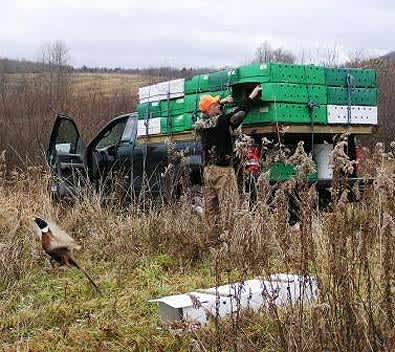Pennsylvania Board Closes Pike Run Wild Pheasant Recovery Area
OutdoorHub 01.25.12

The Board of Game Commissioners today gave preliminary approval to retain four Wild Pheasant Recovery Areas (WPRAs) for the 2012-13 seasons, while closing the Pike Run WPRA in southwestern Pennsylvania.
The agency’s Ring-necked Pheasant Management Plan seeks to restore self-sustaining and huntable populations of wild pheasants in suitable habitats, and specifically calls for the creation of WPRAs. The agency is releasing wild-trapped pheasants into these areas, with a goal of achieving a density of 10 hen pheasants per square mile.
“The Pike Run WPRA in southwestern Pennsylvania has concluded and habitat patch analysis shows that Pike Run meets only one of five targets in the pheasant habitat model,” said Carl G. Roe, Game Commission executive director. “Pheasant densities are at one hen per square mile, which is far short of the 10 hens per square mile objective.
“In light of the area’s habitat characteristics and low pheasant densities, and in keeping with the pheasant management plan, Wildlife Management Unit 2A, which includes the previously designated Pike Run WPRA, is to be opened to hunting male pheasants and stocking of game farm pheasants is to be reinstated beginning with the 2012-13 season.”
Under the WPRA program, small game hunting is prohibited in the designated areas, as well as the release of any artificially propagated pheasants – including Game Commission-raised pheasants. Also, to limit disturbances to nesting hen pheasants, dog training of any manner and small game hunting is prohibited in WPRAs from the first Sunday in February through July 31 each year.
The Board also took preliminary steps to allow for crow hunting within WPRAs, which would be added to the exceptions that allow for groundhog and waterfowl hunting within WPRAs, and opened WMU 2B to the hunting of male and female pheasants.
“Working with major partners, such as Pheasants Forever, the California University of Pennsylvania and local landowners, we already have a jump start on creating WPRAs,” Roe said. “These groups have invested in creating the necessary pheasant habitat in these areas of the state.
“The Game Commission will continue to raise and release pheasants on public lands with suitable pheasant habitat each fall. And, with the additional revenues made available through Marcellus shale well leases on State Game Lands, we will increase our pheasant production level to 200,000 birds for the upcoming season.”

